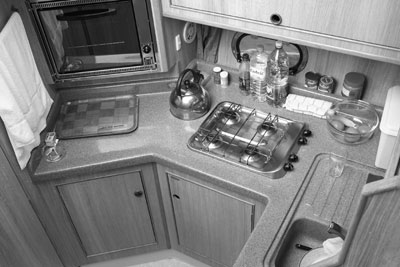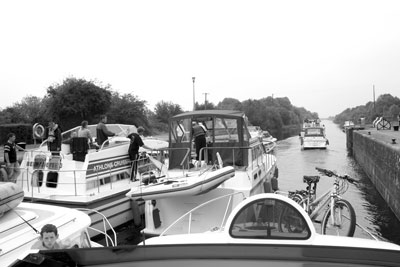Cruising up the Shannon through the 40 shades o’ green
(First of two parts, jump to part 1, part 2)
I close my eyes and picture the emerald of the sea,
From the fishing boats at Dingle to the shores of Donaghadea;
I miss the River Shannon and folks at Skibbereen.
The moorlands and the meadows with their forty shades o’ green.
— Johnny Cash (1961)
As the song says, I can’t stop thinking about Ireland — the glistening River Shannon scrolling out in front of our cozy vessel, the quiet villages, the glorious countryside, all set amidst those incredible 40 shades of green.
Taking command
My wife, Susan, and I began our week-long self-drive Irish cruising adventure in Portumna, in County Galway in south-central Ireland, at the southern headquarters of Emerald Star. We had chosen Emerald Star because it is the largest and most successful company renting self-drive vessels in Ireland. We were quite surprised and impressed to see the size of the fleet; at least 40 vessels, ranging in size from two berths to 10, were docked on either side of the HQ.
We arrived at about 2 p.m., well ahead of the 4-to-6 p.m. rush. This was wise, since it allowed us plenty of time to see the orientation and safety film and to take our handy rental car a mile into town to shop for provisions.
After we stored our groceries, we had a chance to examine our boat, a Consul class, number 22. She was graceful, with a length of 34 feet and a beam of 11 feet; a V-berth cabin forward sleeping two; an aft cabin also sleeping two in a rectangular double bed; a main cabin (living room) with inside steering position; a small but well-planned galley with gas stove, 4-burner cooktop, sink and small fridge; two heads with showers, sinks and marine pump flush toilets; a diesel engine, and a topside bridge and sitting area with an outside steering position. In a pinch, the vessel could sleep one more on a convertible sofa in the main cabin.
She was fully equipped with pots, pans, cutlery, lines, fuel, hot and cold water, sheets, duvets, towels, bicycles (optional) and all other necessities. She was painted in appropriate Irish colors: green and white.
A young instructor came on board and gave Susan and me a rapid-fire briefing on how to operate the vessel and then took us for a brief spin out the marina channel and into the Shannon. He showed us how to quickly turn the vessel “on a dime” (a euro?) by turning the wheel hard over, going ahead hard for a few seconds, then quickly using reverse, then going ahead and so on.
We didn’t want to miss the last opening of the day of the Portumna swing bridge at 5:30 p.m., so after dropping off our instructor and picking up some last-minute supplies, we dashed into the Shannon at our top speed of six knots (about seven miles per hour).
We headed south a few yards through the bridge opening and thence into Lough Derg. We were still a bit apprehensive about maneuvering the boat and understanding the buoy system, but literally within minutes we got the hang of it and started to relax and enjoy the scenery.
First mooring
And what scenery! Off to starboard in the afternoon sun was Portumna Castle, built in 1618, while opening out ahead of us was the beautiful Lough Derg, one of the largest and most famous lakes in Ireland. The gentle green hills rose up from the lake, and there was literally no ugly development anywhere in sight, just a few charming houses, churches and cottages that seemed just right for the landscape.
Our position on the bridge gave us excellent all-around visibility. Reading the easy-to-use chart, we spotted our destination for the night off to port, the little village of Terryglass.
Approaching the tiny Terryglass marina, we found an empty space on the quay and easily came alongside and tied up. Late-arriving vessels sometimes rafted up (doubled up) by tying onto vessels that were docked at the quay — apparently, one should ask permission if the owner of the quayside vessel is on board, but otherwise it is okay just to raft up and climb over the inboard boat.
Terryglass lived up to its guidebook billing as a lovely village, with several wells dedicated to saints, a cute Garda (police) station and a fun pub and a restaurant. The restaurant, the Derg Inn, served a spectacular fish goujons (strips) in kataffi (filo threads) pasty. The dish was wonderfully crisp, with creamy white fish inside, and our meal cost about $38 for two. Irish cooking has certainly improved since I last visited in 1965!
At dinner we chatted with two local men who also were docked at the marina. They had rented from Emerald Star for many years, were impressed with the line and eventually bought a used cruiser from the organization. Now they cruise every weekend on a different part of the Shannon. Lucky fellows!
The beautiful Shannon
The next day, after a good night’s sleep, we rose, made a quick breakfast and got under way. The weather was sunny, with a few clouds, and the temperature in early September was a very pleasant 60 to 67 degrees. We sailed south for several miles to examine the lake and catch a glimpse of Castle Clondagough. Then we turned north and reentered the Shannon at the Portumna swing bridge.
The Shannon starts at Shannon Pot in County Cavan in the north of the island and heads generally south and southwest for about 210 miles through 10 of Ireland’s 32 counties and through several lakes and various locks until it reaches the sea west of Limerick. It is the longest and most important river in Ireland.
It is also one of the most beautiful rivers in the world. Where we were sailing, it was about 60 to 100 yards wide, with very clean but dark water, rather like the Suwannee River in northern Florida. Close aboard to port and starboard were restful green fields, mostly of grass to feed the numerous cattle who stared at us as we passed.
The river sometimes split around low islands with small trees, marshes and beautiful cattails. We spotted herons, numerous swans and goslings, horses, many fishermen and occasional farmhouses and picturesque ruined manor houses. We never encountered any heavy commercial river traffic and often had stretches of the river entirely to ourselves. Most of the other boaters were Irish, with some continental Europeans and almost no Americans.
At Meelick we encountered our first lock. We had heard from cruisers in England that these required quite a bit of work, but here in Ireland it was “easy-peasy.” We simply sailed into the lock with several other recreational vessels and looped lines over bollards at the top of the walls of the lock. Then the lockkeeper opened valves in the upstream end of the lock, the water rose and we sailed out, eight feet higher, ready to see a whole new section of river.
The cost? About two dollars. One of the best bargains in Ireland!
Arranging a voyage
Emerald Star is represented across Europe and the U.S. by Crown Blue Line (980 Awald Rd., Ste. 302, Annapolis, MD 21403; call 800/992-0291, e-mail info@leboat.com or visit www.crownblueline.com). A week-long voyage from Portumna in an Emerald Star boat similar to ours will cost about $2,116 in fall 2006.
The Toulmins received from Crown Blue Line and Emerald Star complimentary use of the motorboat on their Shannon River voyage but paid for fuel costs (about $300) as well as meals and airfare.
—The Cruising World is written by Lew Toulmin.


